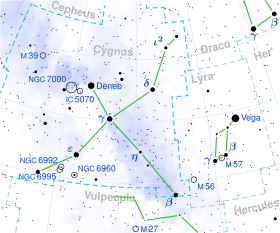피씨그니
Phi Cygni| 관측 데이터 에폭 J2000 이쿼녹스 J2000 | |
|---|---|
| 별자리 | 백조자리 |
| 우측 상승 | 19h 39m 22.60591s[1] |
| 탈위임 | 30° 09′ 11.9604″[1] |
| 겉보기 크기 (V) | 4.70[2] (5.31 + 5.6)[3] |
| 특성. | |
| 스펙트럼형 | K0III + K0III[3] |
| U-B색지수 | +0.81[2] |
| B-V색지수 | +0.98[2] |
| 아스트로메트리 | |
| 방사 속도 (Rv) | +4.50km[4]/s |
| 고유 운동 (μ) | RA: +2.48마스[1]/yr Dec.: +36.50[1]mas/yr |
| 시차 (π) | 12.25 ± 0.24[1] 마스 |
| 거리 | 266 ± 5 리 (82 ± 2pc) |
| 절대치수 (MV) | +0.12[5] (+0.77/+1.07)[6] |
| 궤도 | |
| 기간 (P) | 434.130일[7] |
| 반주축 (a) | 26.9[3] mas″ |
| 편심성 (e) | 0.5557[7] |
| 기울기 (i) | 80.8[3]° |
| 노드의 경도 (Ω) | 251[3]° |
| 페리아스트론 신기원을 이루다 (T) | 2451239.58[7] |
| 페리아스트론의 인수 (ω) (2차) | 209.41[7]° |
| 반암도 (K1) (iii) | 26.40km[7]/s |
| 반암도 (K2) (2차) | 27.22km[7]/s |
| 세부 사항 | |
| A | |
| 미사 | 2.16[8] M☉ |
| 반지름 | 8.9[7] R☉ |
| 루미도 | 44[7] L☉ |
| 온도 | 4,875[7] K |
| 금속성 [Fe/H] | -0.11[7] 덱스 |
| 회전 속도 (v sin i) | 4.7km[7]/s |
| B | |
| 미사 | 2.06[8] M☉ |
| 반지름 | 7.8[7] R☉ |
| 루미도 | 34[7] L☉ |
| 온도 | 4,875[7] K |
| 회전 속도 (v sin i) | 4.8km[7]/s |
| 나이 | 0.65[9] Gyr |
| 기타 지정 | |
| 데이터베이스 참조 | |
| 심바드 | 자료 |
Phi Cogni는 from Cogni에서 라틴어로 표기된 것으로, 시그너스 북쪽 별자리에 있는 2진 별 체계다[11].그것은 육안으로 볼 때 4.70의 겉보기 시야로 희미하게 보인다.[2]연간 시차 이동은 지구에서 측정했을 때 12.25 마스인데[1], 약 266광년의 거리 추정치를 산출한다.그것은 방사상 속도 +4.5 km/s로 태양으로부터 더 멀리 이동하고 있다.[4]
φ 시그니는 이중선 분광형 이항계통으로, 두 성분의 흡수선이 스펙트럼에서 볼 수 있음을 의미한다.두 세트의 스펙트럼 라인은 거의 동일하며, 두 별에는 K0의 스펙트럼 타입이 할당된다.III, 즉 그들이 거인으로 진화했다는 뜻이다.이들은 중심 헬륨 융합을 시작하고 수평 가지에 누워있는 별인 붉은 덩어리 거성으로 여겨지고 있지만, 그들의 금속성과 수소 봉투의 크기 때문에 그들은 붉은 거대한 가지와 매우 가까운 곳에서 발견된다.[8][12]두 별의 나이는 6억 5천만 년 정도 될 것으로 추정된다.[9][6]이 쌍은 궤도 주기가 434.208일 또는 1.2년, 반조르 축 26.9 mas, 높은 편심률 0.56이다.[7]
참조
- ^ a b c d e f van Leeuwen, F. (2007). "Validation of the new Hipparcos reduction". Astronomy and Astrophysics. 474 (2): 653–664. arXiv:0708.1752. Bibcode:2007A&A...474..653V. doi:10.1051/0004-6361:20078357. S2CID 18759600. Vizier 카탈로그 항목
- ^ a b c d Fernie, J. D. (June 1969), "UBV observations of miscellaneous stars", Journal of the Royal Astronomical Society of Canada, 63: 133–135, Bibcode:1969JRASC..63..133F.
- ^ a b c d e Pourbaix, D (2000). "Resolved double-lined spectroscopic binaries: A neglected source of hypothesis-free parallaxes and stellar masses". Astronomy and Astrophysics Supplement. 145 (2): 215–222. Bibcode:2000A&AS..145..215P. doi:10.1051/aas:2000237.
- ^ a b Pourbaix, D.; et al. (2004), "SB9: The Ninth Catalogue of Spectroscopic Binary Orbits", Astronomy & Astrophysics, 424 (2): 727–732, arXiv:astro-ph/0406573, Bibcode:2004A&A...424..727P, doi:10.1051/0004-6361:20041213, S2CID 119387088.
- ^ Anderson, E.; Francis, Ch. (2012), "XHIP: An extended hipparcos compilation", Astronomy Letters, 38 (5): 331, arXiv:1108.4971, Bibcode:2012AstL...38..331A, doi:10.1134/S1063773712050015, S2CID 119257644.
- ^ a b Armstrong, J. T; Hummel, C. A; Quirrenbach, A; Buscher, D. F; Mozurkewich, D; Vivekanand, M; Simon, R. S; Denison, C. S; Johnston, K. J; Pan, X.-P; Shao, M; Colavita, M. M (1992). "The orbit of Phi Cygni measured with long-baseline optical interferometry - Component masses and absolute magnitudes". Astronomical Journal. 104: 2217. Bibcode:1992AJ....104.2217A. doi:10.1086/116396.
- ^ a b c d e f g h i j k l m n o p Massarotti, Alessandro; Latham, David W; Stefanik, Robert P; Fogel, Jeffrey (2008). "Rotational and Radial Velocities for a Sample of 761 HIPPARCOS Giants and the Role of Binarity". The Astronomical Journal. 135 (1): 209–231. Bibcode:2008AJ....135..209M. doi:10.1088/0004-6256/135/1/209.
- ^ a b c Fekel, F. C (2004). "The Spectroscopic Orbit of φ Cygni, a System with Two Late-Type Giants". The Environment and Evolution of Double and Multiple Stars. 21: 63. Bibcode:2004RMxAC..21...63F.
- ^ a b Soubiran, C; Bienaymé, O; Mishenina, T. V; Kovtyukh, V. V (2008). "Vertical distribution of Galactic disk stars. IV. AMR and AVR from clump giants". Astronomy and Astrophysics. 480 (1): 91–101. arXiv:0712.1370. Bibcode:2008A&A...480...91S. doi:10.1051/0004-6361:20078788. S2CID 16602121.
- ^ "* phi Cyg". SIMBAD. Centre de données astronomiques de Strasbourg. Retrieved 2016-04-10.
- ^ Eggleton, P. P.; Tokovinin, A. A. (September 2008), "A catalogue of multiplicity among bright stellar systems", Monthly Notices of the Royal Astronomical Society, 389 (2): 869–879, arXiv:0806.2878, Bibcode:2008MNRAS.389..869E, doi:10.1111/j.1365-2966.2008.13596.x, S2CID 14878976 Vizier 카탈로그 항목
- ^ Armstrong, J. T; Hummel, C. A; Quirrenbach, A; Buscher, D. F; Mozurkewich, D; Vivekanand, M; Simon, R. S; Denison, C. S; Johnston, K. J; Pan, X.-P; Shao, M; Colavita, M. M (1992). "The orbit of Phi Cygni measured with long-baseline optical interferometry - Component masses and absolute magnitudes". Astronomical Journal. 104: 2217. arXiv:1304.2530. Bibcode:1992AJ....104.2217A. doi:10.1086/116396.



